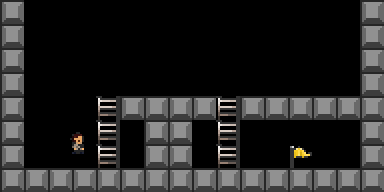A reimplementation on steroids of the original py-vgdl by Tom Schaul.
Under heavy and active development, just check the latest timestamps in the git history.
VGDL stands for Video Game Description Language. PyVGDL is an easily scriptable video game engine written in Python, ideal for artificial intelligence research.
Given a game description, it allows you to turn something like
w w
w w
w w
w w
w HwwwwHwwwwww
w H ww H w
wA H ww H G w
wwwwwwwwwwwwwwww
… into a human or AI-playable game:
PyVGDL aims to be an engine first, interfacing with different frameworks such as OpenAI Gym (gym_vgdl) and pybrain.
The easiest way to install VGDL as a library with all its dependencies is to run
pip install 'git+https://github.com/rubenvereecken/py-vgdl/#egg=vgdl[all]'Alternatively, if you know you will only be using the PyBrain or OpenAI Gym interface, run one of these to get just the necessary dependencies.
# Gym
pip install 'git+https://github.com/rubenvereecken/py-vgdl/#egg=vgdl[gym]'
# PyBrain
pip install 'git+https://github.com/rubenvereecken/py-vgdl/#egg=vgdl[pybrain]'The recommended way to install it if you want to play around with examples is through a local installation.
git clone https://github.com/rubenvereecken/py-vgdl
pip install -e 'py-vgdl[all]'You'll need Python >= 3.6. This is so we can have nice things.
PyVGDL is excellent for designing your own problem environments that still share some standard characteristics. It supports grid phyics and continuous phyics.
You probably want to use one of several standard interfaces:
Read ahead to figure out how best to get started with either.
Install pyyaml and tensorboard:
pip install PyYAML
pip install tensorboardEdit the config file as necessary and run training:
python3 train.py --config=config.ymlTrack progress by running:
tensorboard --logdir <log_dir> --port=<port> --bind_alland navigating to victoria.csail.mit.edu:<port>
Example code is included that relies on VGDL's Gym interface to demonstrate the engine through human game play. Give it a go:
# Any of the games in vgdl/games will work
python -m vgdl.util.humanplay.play_vgdl vgdl/games/aliens_lvl0.txtDefinitely check out all the other examples demonstrating human play (with recording and replay), reinforcement learning, planning, and of course writing your own games to do any number of these things.
- A more full-fledged VGDL implementation is written and maintained for the General Video Game AI Competition, so look there for more features and expressability. It features a server-client model written in Java, tailored for the competition, whereas this repository aims to be a complete yet lightweight Python implementation for AI research.
- While manual testing has been done by multiple parties, we are in desperate need of unit and scenario tests.
- Some more basic ontology functionality is welcome.
- Could use another PEP check.
